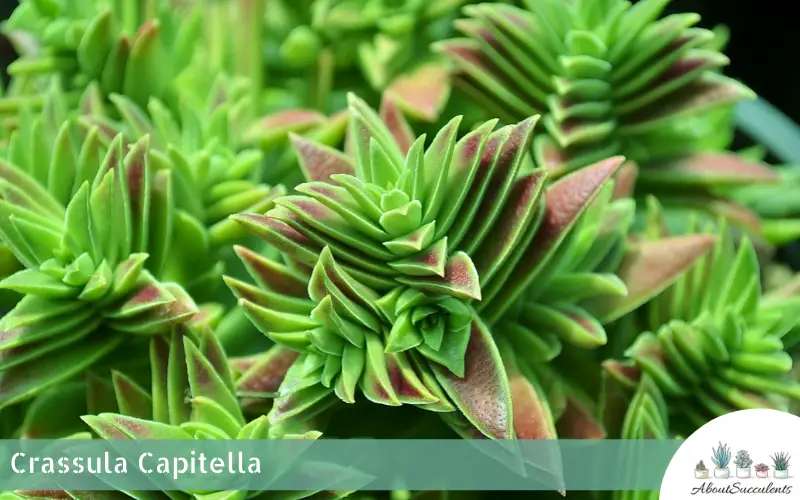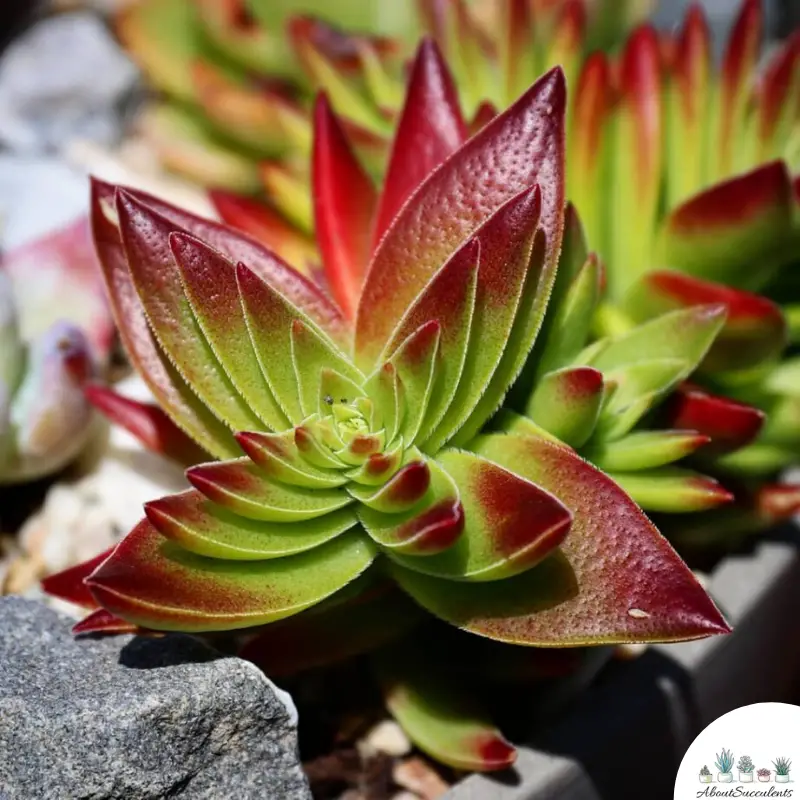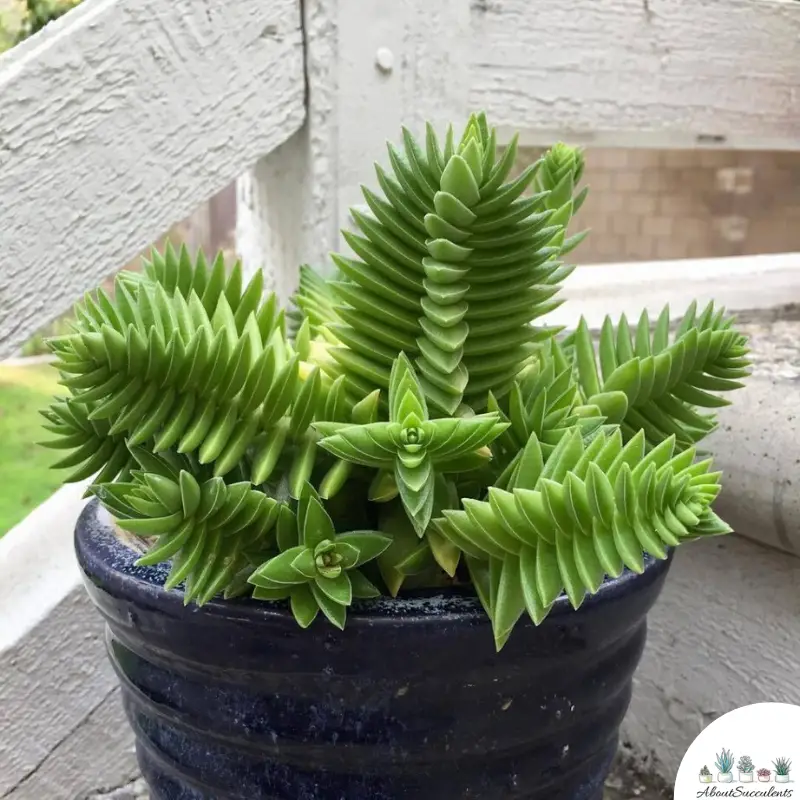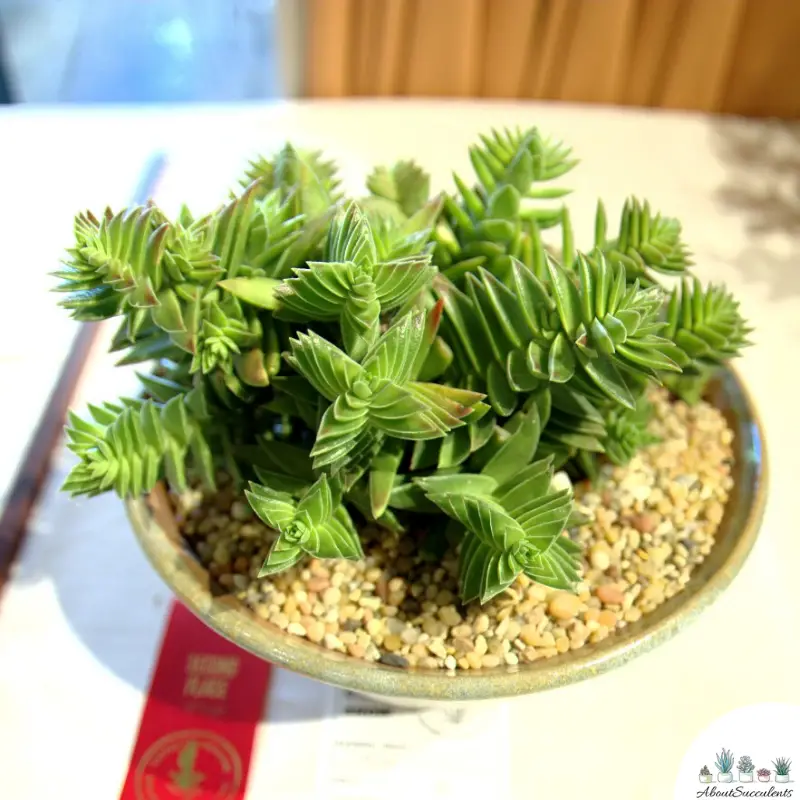
Crassula Capitella is an eye-catching succulent that can brighten up a garden. The plant is highly-recognizable by its propeller-like leaves that change from lime green to bright red. Crassula Capitella grows into thick, fleshy mats that are 6-inches (15cm) tall and 3-feet (90cm) wide. The fiery red color of its leaves and the sprawling development of this succulent have given it the names “Campfire” and “Red Flames”.
Crassula Capitella belongs to the Crassulaceae family and is native to South Africa.
General Information:
Also known as: Campfire Crassula, Red Flames
Plant Family: Crassulaceae
Origin: South Africa
Height: 6-inches (15cm) tall
Exposure: 3 to 6 hours of sunlight; partial shade in the winter.
Water Needs: Frequent watering in the summer; low watering in the winter.
Soil Type: Cactus soil or a combination of loam, sand and potting soil.
Soil pH: Acidic (5.0 to 5.5)
Maintenance Requirements: Low
Tolerance: Winter
How to Grow and Care for Crassula Capitella / Campfire

Campfire is a low maintenance succulent plant that can be grown indoors. It is recommended to grow Crassula Capitella outdoors because it needs sunlight for its leaves to turn bright red. Regular exposure to sunlight will also help the succulent produce its white flowers. If kept indoors, its leaves will remain bright lime green.
Crassula Capitella is used as a captivating groundcover in a garden or a rocky landscape. The ideal temperature to grow Campfire is 30° F (-1.1° C). Campfire can survive cold weather temperature of as low as 30°F (-1.1°C).
If you live in a region that gets colder than this temperature, make sure Campfire is planted in a pot that can be brought inside the home.
Sunlight
Plant Crassula Capitella in an area in the garden that gets 6 hours of sunlight per day. If the succulent is brought indoors, it should be located near a window that receives 3 to 6 hours of sunlight per day.
Watering
Crassula Capitella grows best with infrequent waterings. If Campfire remains immersed in water for long periods, its roots will begin to rot. Before you water the succulent, feel the soil and check if it’s dry to the touch. Once you are confident that the soil is completely drained of moisture, water the plant until the soil is saturated.

The soil remains moist for a longer period during the cold season. Crassula Capitella should have fewer waterings in winter.
Pot and Soil
The pot for Crassula Capitella should have good drainage holes to allow excess water to flow out of the soil. A clay pot that measures 2.5-inches to 4-inches (6cm to 10cm) in diameter would be ideal to grow Campfire.
This succulent will thrive in well-drained soil such as cactus soil or a combination of loam, sand and potting soil that has a pH level of 5.0 to 5.5. It is recommended to fertilize Campfire with compost twice-a-year.
How to Propagate Crassula Capitella
The Crassula Capitella succulent can be propagated with the use of 3 methods: Leaf-cutting, small stem cutting, and seeds.
Before propagating Crassula Capitella, you must ensure that the succulent has good quality soil to grow in. It is important for the type of soil to have good circulation in the roots to allow for the proper removal of excess water.

If you decide to use commercially-available potting soil, choose a brand that is free of weeds, porous, lightweight, and sterilized to prevent fungal growth.
You can add peat moss to the potting soil to improve moisture and air circulation around the roots. A combined mixture of 1 part sand and 1 part perlite will further improve the quality of the potting soil.
Leaf Cuttings Method
Step 1: Use a sharpened knife or a pair of scissors that have been sterilized to cut the leaves. The cuttings should measure around 5-inches or 12cm.
Step 2: Place the leaf cuttings under a shaded area and allow them to dry for a few days. The leaf cuttings will be ready for propagation once they have developed calluses.
Step 3: Once the leaf cuttings are ready, simply place them on the soil. Do not bury the leaves into the soil. Its roots will naturally find their way into the soil.
Stem Cutting Method
Step 1: Remove the stems from the succulent by using a sharp pair of pruners that have been sterilized. The stems should measure 2-inches to 4-inches (5cm to 10cm) and have 2 sets of nodes for rooting. You can uncover the nodes by removing the leaves from the stems.
Step 2: Leave the stem cuttings over the potting soil and under a shaded area for 2 to 3 days or until they develop calluses.
Step 3: When the stems have callused properly, you can insert the root end into the dry potting soil mix. Give the stems some space to grow properly.
Step 4: Place the pot in an area that receives indirect sunlight.
Step 5: After 2 weeks, mist the soil then increase the frequency of misting to every week.
Seed Method
Step 1: Sow the Campfire seeds in well-draining soil.
Step 2: If you want to grow the succulent outdoors, make sure your region has the ideal temperature to support Crassula Capitella.
Step 3: If you want the Crassula Capitella to grow indoors, place the seeds under a grow light.
Frequently Asked Questions
Is Crassula Capitella Toxic for Cats and Dogs?
A search query for “Crassula Capitella” in the website of the American Society for the Prevention of Cruelty to Animals (ASPCA) will yield a result for Crassula Argentea which is also a member of the Crassulaceae family. For safety reasons, it is best to keep Campfire away from your house pets.
Why is my Crassula Capitella Succulent Dying?
There are 3 possible reasons for the Crassula Capitella dying: Overwatering, underwatering, freezing temperatures, and infestation from pests and diseases. Find out more about the causes and how to avoid these conditions in the sections below.
1. Overwatering
Giving Crassula Capitella too much water will cause the roots to rot. Do not water until the soil is dry and completely free of moisture. If you prefer to water Campfire by placing it in a saucer of water, remove the excess water after a few minutes.
2. Underwatering
Crassula Capitella is a type of succulent that needs frequent watering during the summer season because the soil dries up faster. Water the succulent whenever the soil is dry to the touch.
3. Freezing Temperatures
Crassula Capitella’s leaves will develop brown spots when temperatures fall below 30° F (-1.1° C). Crassula Capitella can tolerate chilly to frosty weather but not freezing temperatures.
If you live in an area where the temperature drops to extreme levels, it is advised to plant Campfire in a container that can be transferred to an area that has partial shade.
4. Pests and Diseases
Mealybugs are attracted to Crassula Capitella. You can tell if Campfire has been infested by mealybugs when you see white, cotton-like fuzz appear on its leaves and stems.
To remove the mealybugs, apply some rubbing alcohol on a paintbrush and dab it on the crab-like insects.
Rapid changes in the moisture content of the soil may lead to Campfire developing a fungal disease called foliage edema. To ensure proper moisture, use the right soil and observe good watering practices.
Does Crassula Capitella Produce Flowers?
In the summertime, Campfire produces white flowers on its stems. The flowers have a star-like shape and measure 4mm or 0.15-inches. For the succulent to bloom, it must receive 6 hours of sunlight per day.
Last Updated on June 10, 2022 by Sofia Lara